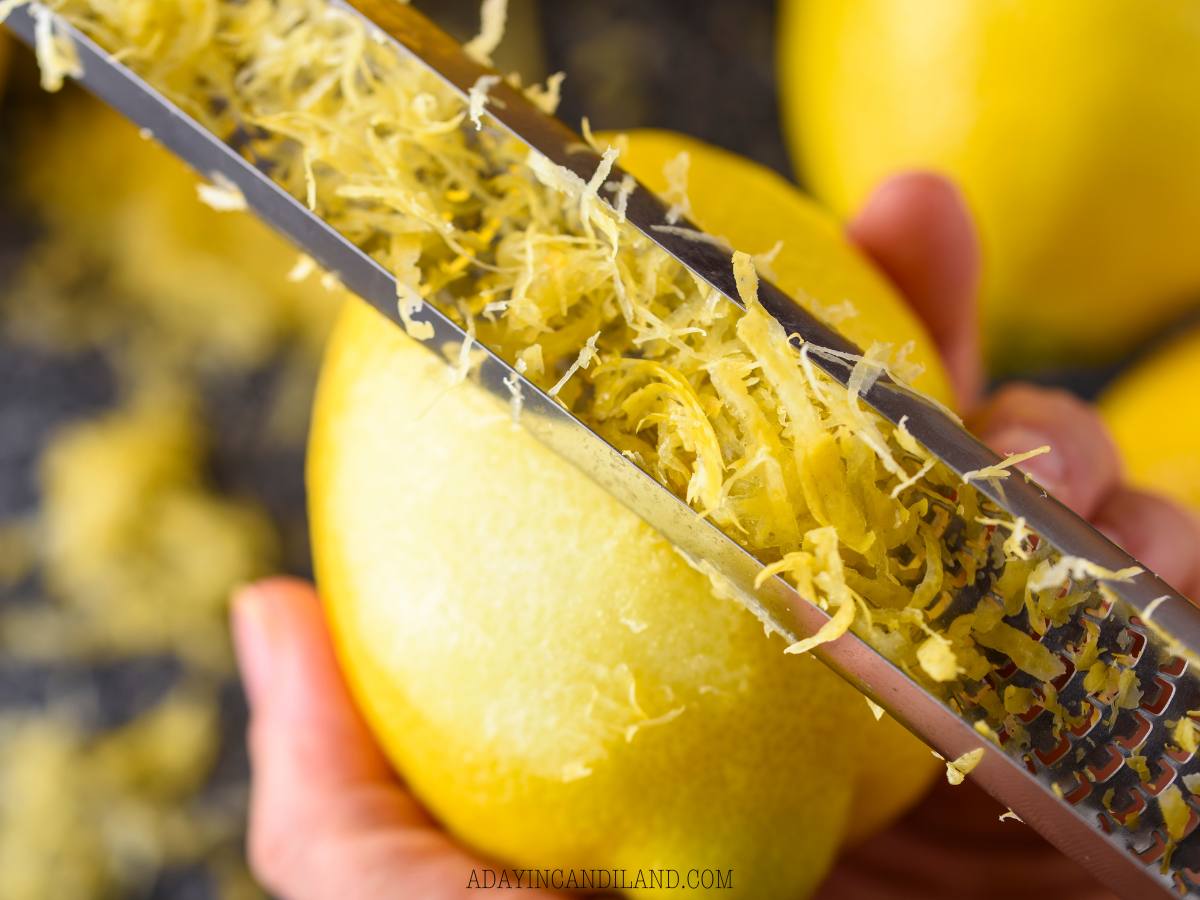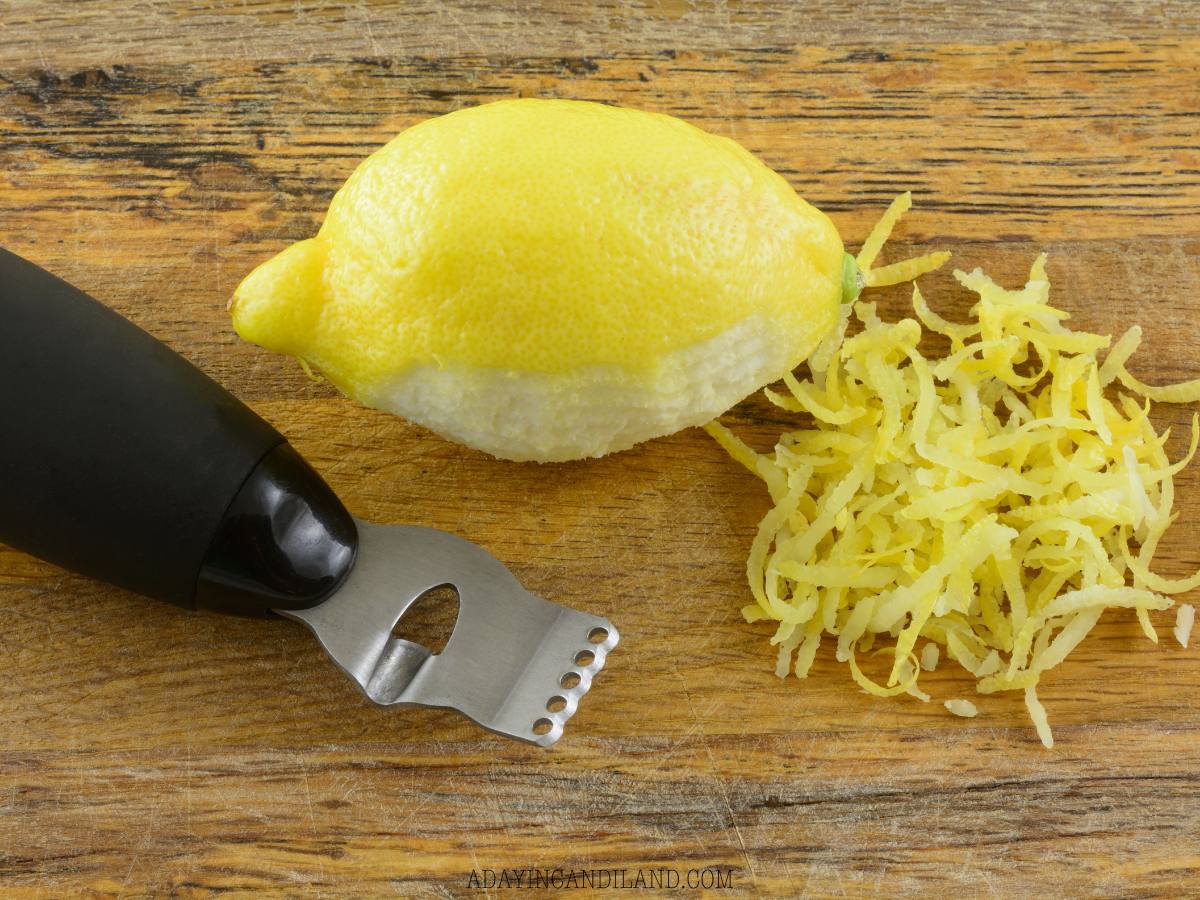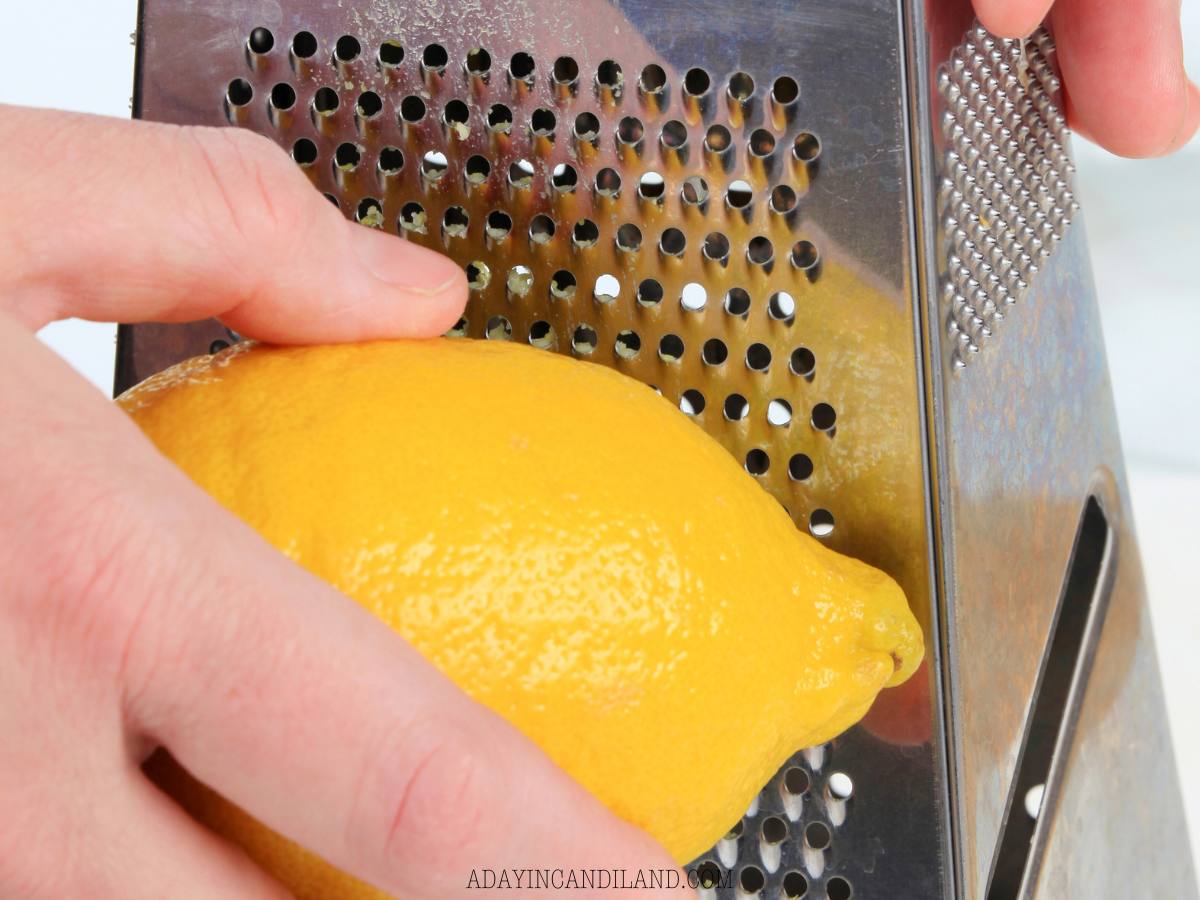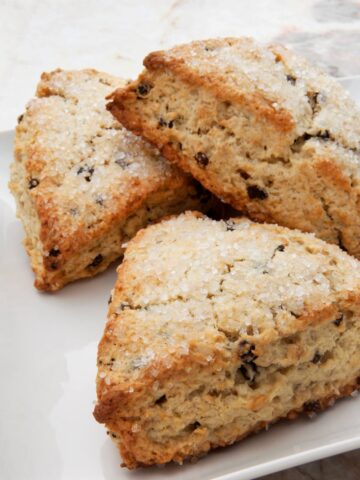Zesting a lemon is a culinary skill that can elevate the flavors in your dishes, adding a burst of citrusy freshness. We’ll explore the act of zesting a lemon using four essential tools: a Microplane, a citrus zester, a paring knife, and a cheese grater.
Whether you’re an experienced chef or a home cook, mastering the techniques of lemon zest extraction can enhance the taste and aroma of your favorite creations. Let’s visit these different tools and choose the best tool with your available kitchen tools. Don’t miss one of my favorite easy lemon recipes on the blog for these Lemon Bars.

Jump to:
Benefits of Using Lemon Zest
- Flavor Enhancement: The lemon zest adds a layer of citrusy freshness to the baked goods and savory meals, brightening and enhancing the overall flavor profile.
- Aroma: The natural essential oils in lemon zest contribute to a delightful aroma that wafts through the kitchen as the zest your lemons. This aromatic quality can make the eating experience more enjoyable.
- Balancing Sweetness: Lemon zest can act as a natural flavor balancer, cutting through the sweetness of some fruits.
- Versatility: Lemon zest is a versatile ingredient that can be used in both sweet and savory dishes. It’s an addition to baked goods, like these lemon scones.
How to Choose The Best Lemons for Zesting
- Look for Vibrant Color: Select lemons with bright, vibrant yellow skin. Avoid ones that appear dull or have a greenish tint, as these may not be fully ripe.
- Firmness: Choose lemons that feel firm and heavy for their size. A firm texture indicates juiciness, while a heavy lemon typically has more lemon juice.
- Smooth Skin: Opt for lemons with smooth, blemish-free skin. Rough or wrinkled skin may be a sign of dehydration or age.
- Thin Skin: Lemons with thin, smooth skin are usually easier to zest. Thin-skinned varieties, such as Eureka lemons, are often preferred for zesting.
- Aromatic Smell: Give the lemons a gentle squeeze and check for a fragrant, citrusy aroma. Aromatic lemons are likely to have flavorful zest.
How to Prepare Lemons for Zesting
- Wash Thoroughly: Rinse the lemons under cold water to remove any dirt, wax, or pesticides. Use a brush to scrub the surface gently.
- Dry Completely: Pat the lemons dry with a clean kitchen towel or paper towel. Dry lemons are easier to handle and zest.
- Room Temperature: Allow the lemons to come to room temperature before zesting. Warmer lemons yield more juice and aromatic oils.
- Zest Before Juicing: If you need both zest and juice, zest the lemons before juicing. Zesting is easier on whole lemons, and you’ll capture the essential oils.
- Avoid the Bitter Pith: When using a zesting tool, be cautious not to include the bitter white pith. Zest only the outer, colored layer of the skin.
- Zest in Strips or Grate Finely: Depending on your recipe, zest the lemons in thin strips using a peeler or microplane, or grate finely using a cheese grater. Experiment with different textures.
- Rotate the Lemon: Rotate the lemon as you zest to ensure you’re getting zest from different areas. This helps avoid overusing one section of the lemon.
- Consider Lemon Varieties: Experiment with different lemon varieties, such as Meyer lemons, which have a sweeter and less acidic flavor, or Eureka lemons for a classic, tangy taste.
4 Ways to Zest a Lemon
The Microplane Zester
The microplane grater is a versatile kitchen tool that excels at extracting oils from lemon zest. Its fine, razor-sharp blades make it easy to create delicate lemon zest without incorporating the bitter pith.
To use the Microplane, hold the lemon firmly and glide the tool across the surface, applying gentle pressure. The result is a pile of fine lemon zest that can be sprinkled over salads, and desserts, or used to flavor sauces and marinades. The microplane’s precision ensures you get the most out of your lemon without any unwanted bitterness.

Citrus Peeler
A citrus peeler is another excellent choice for extracting lemon zest, especially if you prefer long strips. Begin by slicing off the top and bottom of the lemon to create stable surfaces.
Insert the curved end of the citrus peeler just under the skin and slide it around the lemon, keeping the tool close to the fruit’s surface. Using the channel knife, allows you to obtain beautiful, wide strips of lemon zest, perfect for garnishing cocktails, and infusing oils, and works with lemon zest, lime zest, and orange zest.

Cheese Grater
For those who may not have a microplane or citrus peeler on hand, a box grater can serve as a practical alternative. Opt for the finer side of the grater to achieve a texture similar to that of the microplane.
Simply rub the lemon against the grater’s surface, taking care to avoid the bitter white part called the pith. The cheese grater is a common kitchen tool that can produce zest suitable for various recipes. Experiment with different dishes to see how the grated lemon zest enhances the overall taste.

Sharp Paring Knife
For those who appreciate a hands-on approach, a paring knife can be a reliable companion in the quest for lemon zest. While not as specialized as a Microplane or citrus peeler, a paring knife offers precision and control. Begin by washing and drying the lemon thoroughly. Using the sharp knife and cutting board, carefully remove the thin outer layer of the lemon peel, ensuring to avoid the bitter pith beneath. Take your time and make thin, consistent cuts to achieve the desired zest.
The paring knife allows you to create custom shapes and sizes of zest, making it a preferred choice for those looking to add a personal touch to their dishes. Keep in mind that this method requires a bit more skill and practice, but the results can be pleasing. Experiment with different cutting techniques, such as julienne or chiffonade, to explore creative ways to incorporate lemon zest into your foods.
Remember to handle the paring knife with care, and always work on a stable surface to ensure safety. With a little practice, you’ll be able to wield the paring knife like a pro, extracting flavorful zest that enhances the taste and presentation of your favorite dishes.

Creative Ways to Use Lemon Zest
- Infused Water and Beverages: Add lemon zest to your water or iced tea for a refreshing and citrusy twist. Use lemon zest to infuse flavor into cocktails, such as martinis or mojitos.
- Homemade Citrus Salt: Mix lemon zest with coarse sea salt to create a flavorful citrus-infused salt. Sprinkle it over grilled vegetables, fish, or rim cocktail glasses.
- Lemon Zest Butter: Mix finely grated lemon zest into softened butter. This lemon-infused butter can be used as a spread for bread or as a finishing touch for grilled meats and vegetables.
- Lemon Sugar: Combine lemon zest with granulated sugar to create lemon sugar. Use it to sweeten your tea or coffee, or sprinkle it over baked goods before baking.
- Lemon-Infused Olive Oil: Combine lemon zest with extra virgin olive oil to create a citrus-infused oil. Drizzle it over salads, roasted vegetables, or grilled chicken for a burst of flavor.
- Homemade Lemon Curd: Make your own lemon curd by combining lemon zest with eggs, sugar, and butter. Use it as a filling for tarts, or lemon cupcakes, or spread it on toast.
Zesting Precaution Tips:
- Bitter Pith Avoidance: When zesting, be cautious not to include the bitter white pith beneath the zest. The pith can impart an unpleasant bitterness to your dishes.
- Organic Lemons for Zesting: When possible, choose organic lemons for zesting. Non-organic lemons may have been treated with pesticides, and washing might not completely remove residues.
- Microplane Safety: Exercise caution when using a microplane, as its sharp blades can cause injury. Keep fingers away from the blade and use gentle pressure to avoid accidental cuts.
- Cleaning Tools Properly: Clean your zesting tools thoroughly after each use. Residual zest can build up and affect the flavor of future dishes.
- Storage Considerations: If you’re not using the zest immediately, store it in a small airtight container in the refrigerator. This helps preserve its freshness and flavor.
- Allergies and Sensitivities: Be mindful of any allergies or sensitivities to citrus. Some individuals may be allergic or sensitive to citrus fruits, including the zest.
- Paring Knife Safety: If using a paring knife for zesting, practice proper knife safety. Keep fingers away from the blade, use a stable cutting surface, and cut away from your body.
Incorporating lemon zest or lemon zest substitute into your cooking or baked goods opens up a world of flavor possibilities. Whether you’re using specialized tools like a Microplane, citrus zester, vegetable peeler, or your trusty old cheese grater, each method brings its unique qualities to the table.





